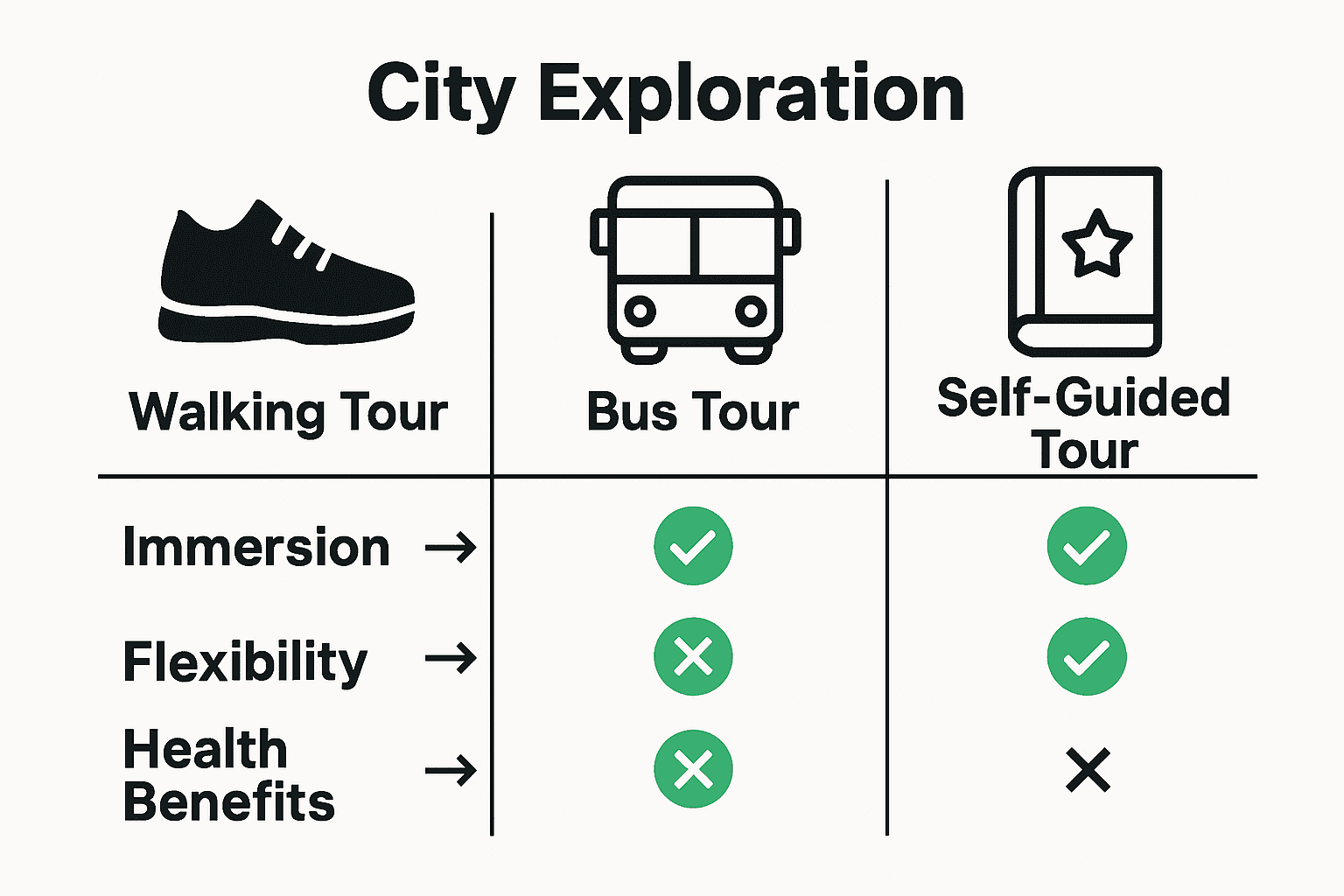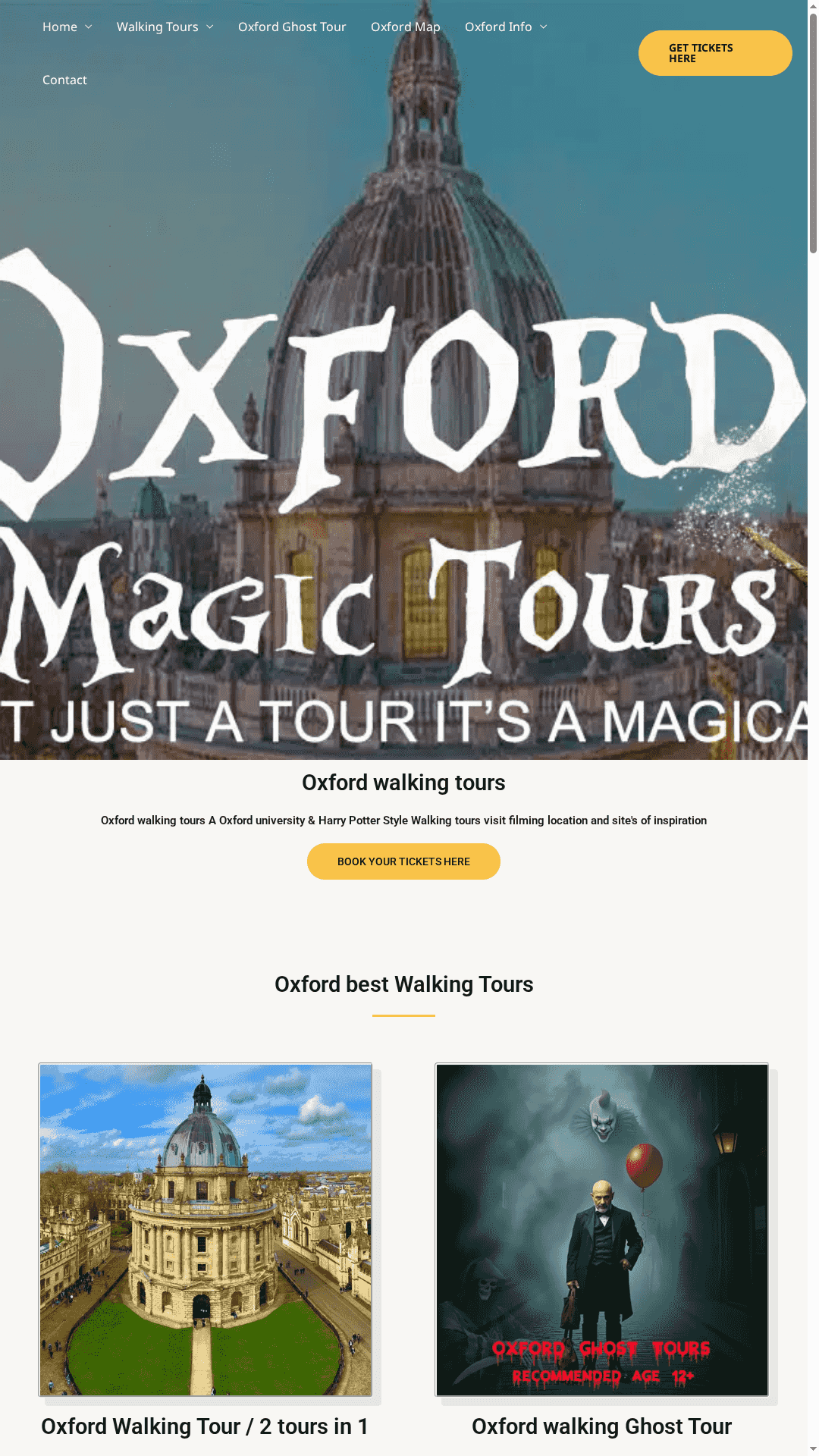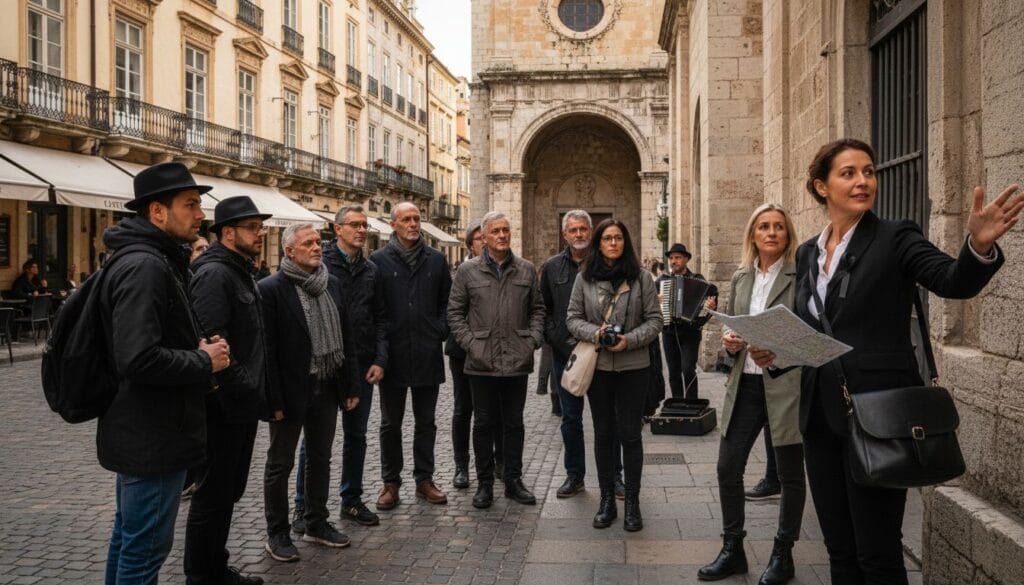More than 80 percent of travelers say walking tours help them connect with a city in ways no bus or taxi ride ever could. Today, these experiences are not just about sightseeing but about truly stepping into the story of a place. Whether you crave rich history, hidden alleyways, or local flavors, walking tours bring destinations to life at street level. This guide reveals what makes these journeys so unique and how they deliver far more than an ordinary stroll.
Table of Contents
- What Walking Tours Really Are
- Variations Of Walking Tours Available
- How Walking Tours Work In Practice
- Health And Cognitive Benefits Of Walking Tours
- Cultural And Local Immersion Benefits
- Things To Know Before Booking (Costs, Safety, Accessibility)
Key Takeaways
| Point | Details |
|---|---|
| Diverse Experiences | Walking tours cater to various interests, including history, culture, nature, and themed topics, enhancing the exploration of different landscapes. |
| Health Benefits | Incorporating physical movement and cognitive engagement, walking tours promote cardiovascular health, stress reduction, and mental stimulation. |
| Cultural Immersion | These tours foster authentic connections with local communities and cultural contexts, transforming conventional sightseeing into meaningful interactions. |
| Preparation is Key | Prior to booking, participants should assess cost, safety, and accessibility factors to ensure a comfortable and enriching experience. |
What Walking Tours Really Are
Walking tours represent a fascinating way to explore historical and cultural landscapes through guided, immersive experiences. According to Wikipedia, these journeys are typically guided walks around historical sites or cultural locations, often situated in urban environments or spanning multiple days through scenic countryside.
Historically, walking tours have deep roots in cultural movements and personal exploration. The Romantic movement of the 18th and 19th centuries significantly influenced their development, with literary figures like William Wordsworth and John Keats pioneering the concept of walking as a method of understanding and experiencing landscapes. Wikipedia notes that in the United Kingdom, walking transformed from a purely functional activity to a leisure pursuit, driven by changing societal attitudes towards nature and personal discovery.
Modern walking tours offer diverse experiences that cater to different interests and preferences. These guided journeys can focus on various themes such as:
- Historical narratives and architectural insights
- Cultural and artistic explorations
- Literary and heritage site discoveries
- Urban photography and architectural studies
- Culinary and local lifestyle experiences
Unlike traditional tour formats, walking tours provide an intimate, ground-level perspective that allows participants to engage directly with their surroundings. Guided vs Self-Guided Oxford Tours can offer deeper understanding through expert commentary, storytelling, and nuanced local knowledge that transforms a simple walk into an educational and entertaining journey.
Walking tours are more than just physical movement through space – they are narrative experiences that connect travelers with the essence of a location, offering insights that traditional transportation modes cannot provide. By moving at a human pace, participants absorb details, listen to stories, and develop a profound connection with the environment around them.
Variations Of Walking Tours Available
Walking tours are incredibly diverse, offering experiences that cater to different interests, fitness levels, and exploration styles. According to Wikipedia, these tours can range from guided urban explorations to extensive countryside journeys, providing travelers with multiple options for discovering new landscapes and histories.
Walking in the United Kingdom highlights the breadth of walking tour experiences, which can be broadly categorized into several distinctive types:
- Urban Historical Tours: Exploring city streets, architectural landmarks, and cultural sites
- Literary and Cultural Tours: Tracing the footsteps of famous writers, artists, and historical figures
- Nature and Countryside Walks: Long-distance routes through scenic landscapes and rural environments
- Themed Specialty Tours: Focusing on specific interests like food, photography, or local folklore
- Archaeological and Heritage Tours: Investigating historical sites and ancient monuments
Self-guided and professionally guided tours offer different experiences for travelers. Walking Tour Types and Benefits demonstrate that while self-guided tours provide flexibility using maps and audio guides, professionally guided tours offer deeper insights through expert commentary and structured narratives.
The complexity and duration of walking tours can vary dramatically. Some tours might last just a couple of hours in a city center, while others could span multiple days across challenging terrain. Participants can choose experiences that match their physical capabilities, interests, and time constraints, making walking tours an adaptable and accessible form of travel exploration.


How Walking Tours Work In Practice
Walking tours operate through carefully structured experiences that blend navigation, education, and exploration. According to Wikipedia, these tours are typically led by knowledgeable guides who provide rich insights into the historical, cultural, and artistic significance of the sites being visited, with flexible pricing models ranging from fixed fees to ‘pay what you want’ arrangements.
Walking in the United Kingdom highlights the practical implementation of walking tours, which generally follow a structured approach. The typical walking tour experience involves several key components:
- Route Planning: Predetermined paths covering significant landmarks
- Guided Interpretation: Expert commentary explaining historical and cultural context
- Group Management: Ensuring participant safety and engagement
- Pacing and Accessibility: Adapting to participants’ physical capabilities
- Interactive Learning: Encouraging questions and direct engagement
Oxford Sightseeing Routes Step by Step demonstrates that successful walking tours require meticulous preparation. Guides typically brief participants at the starting point, outlining the route, expected duration, difficulty level, and key points of interest. This initial orientation helps set expectations and ensures participants are comfortable and prepared.
Practically, walking tours accommodate various learning styles and preferences. Some tours use multimedia presentations, historical reenactments, or interactive storytelling to bring locations to life. The format allows for immediate interaction with the environment, enabling participants to touch historical structures, smell local environments, and experience locations in a way impossible through traditional transportation methods.
Whether exploring urban landscapes or countryside trails, walking tours transform passive sightseeing into an immersive, educational adventure.
Health And Cognitive Benefits Of Walking Tours
Walking tours represent a powerful approach to holistic health, combining physical movement with mental stimulation. According to research from the National Center for Biotechnology Information, engaging in walking tours provides significant health benefits, including improved cardiovascular fitness, enhanced mood, and reduced risks of chronic diseases.
The cognitive advantages of walking tours are particularly remarkable. NCBI research highlights how these tours contribute to mental well-being by promoting cognitive engagement and stress reduction. The unique blend of physical activity and environmental exploration triggers multiple health benefits:
- Cardiovascular Conditioning: Sustained walking improves heart health
- Stress Reduction: Natural environments and gentle exercise lower anxiety
- Cognitive Stimulation: Learning and navigating new environments enhances brain plasticity
- Mental Alertness: Continuous sensory input keeps the mind actively engaged
- Emotional Well-being: Physical movement releases endorphins and improves mood
How to Maximize Oxford Tour Experience suggests that purposeful walking tours can be designed to maximize these health benefits. Unlike monotonous gym exercises, walking tours offer dynamic, interactive experiences that make physical activity feel less like a chore and more like an adventure.
Ultimately, walking tours transform exercise from a mundane activity into an enriching journey. By combining physical movement with mental stimulation, cultural learning, and environmental exploration, participants gain a comprehensive approach to health that nurtures both body and mind. The spontaneity of discovering new locations while maintaining steady physical activity creates a uniquely rewarding experience that traditional fitness routines simply cannot match.
Cultural And Local Immersion Benefits
Walking tours transform travel from passive observation into an active, deeply engaging cultural experience. According to Wikipedia, these journeys allow participants to explore historical and cultural sites firsthand, fostering a profound understanding of local heritage and traditions that goes far beyond typical tourist experiences.
Walking in the United Kingdom highlights how walking tours provide unique opportunities to connect with local landscapes and communities. These immersive experiences reveal cultural nuances that traditional transportation methods completely miss:
- Sensory Engagement: Experiencing local environments through smell, sound, and touch
- Authentic Interactions: Direct encounters with local residents and communities
- Contextual Learning: Understanding historical sites in their original context
- Hidden Narratives: Discovering stories not found in standard guidebooks
- Architectural Appreciation: Experiencing architectural details up close
The Essential Guide to Guided Tours in the UK demonstrates that guided tours offer deeper cultural insights through expert storytelling and contextual interpretation. Guides transform historical sites from mere physical spaces into living narratives, helping participants understand the complex social, historical, and cultural layers that shape a location.
Ultimately, walking tours offer more than just sightseeing – they provide a profound cultural dialogue. By moving slowly through landscapes, engaging with local environments, and listening to expert narratives, travelers develop a nuanced understanding that transcends superficial tourism. Each step becomes an opportunity for cultural discovery, transforming travel from a passive experience into an active, transformative journey of understanding.
Things To Know Before Booking (Costs, Safety, Accessibility)
Booking a walking tour requires careful consideration of multiple factors to ensure an enjoyable and safe experience. According to Wikipedia, potential participants should thoroughly investigate cost structures, safety protocols, and tour accessibility before making a commitment.
Walking in the United Kingdom provides insights into the diverse landscape of walking tour options. Understanding the key considerations can help travelers make informed decisions:
Cost Variations: – Free self-guided tours
- Fixed-price guided experiences
- ‘Pay what you want’ models
- Group and individual pricing options
Safety Considerations:
- Guide qualifications and experience
- Route terrain and difficulty level
- Weather and seasonal conditions
- Emergency preparedness
Accessibility Factors:
- Physical fitness requirements
- Path surfaces and terrain
- Mobility assistance availability
- Alternative route options
Essential Gear for City Walking Tours recommends preparing in advance by understanding the specific requirements of your chosen tour. This includes checking the physical demands, required equipment, and any special preparations needed for the specific route.
Ultimately, the key to a successful walking tour is thorough preparation. Potential participants should communicate directly with tour operators about their specific needs, fitness levels, and any concerns. By asking detailed questions about route difficulty, duration, terrain, and potential accommodations, travelers can ensure they select a walking tour that provides an enriching experience while maintaining personal comfort and safety.
Discover The Magic Of Walking Tours In Oxford
When looking for a walking tour that goes beyond simple sightseeing, it is easy to feel overwhelmed by choices that lack real depth or connection. The challenge is finding a tour that not only guides you through Oxford’s fascinating history but truly immerses you in its culture and storytelling. Many walking tours miss the mark on offering authentic engagement, interactive learning and memorable experiences that stimulate both mind and heart.
At Oxford Magic Tours, we understand these concerns deeply. Our tours bring the enchanting world of Oxford University and Harry Potter filming locations to life with live entertainment from a magician who has performed for the British Royal family and A list celebrities. This unique blend of education, culture and live performance transforms your walk into an unforgettable adventure. Experience expert narration combined with engaging storytelling that captures the very essence of each place you visit.

Why settle for ordinary when you can enjoy an extraordinary walking tour crafted to captivate your senses and enrich your understanding? Take the first step towards a truly immersive experience by exploring our Oxford University walking tours today. Book now to secure your place on the only walking tour in Oxford that combines history, magic and live entertainment in one seamless journey.
Frequently Asked Questions
What are the benefits of taking walking tours?
Walking tours offer numerous benefits, including improved cardiovascular health, mental stimulation, cultural immersion, and authentic local experiences. Participants engage with their environment in a way that traditional tours cannot provide.
How can I choose the right walking tour for my interests?
To choose the right walking tour, consider your interests such as historical narratives, culinary experiences, or literary explorations. Review the tour content, duration, and physical demands to find an experience that matches your preferences.
Are walking tours suitable for all fitness levels?
Yes, walking tours cater to various fitness levels. Some tours are designed to be leisurely and accessible, while others may include more challenging terrain. Always check the tour details to find an option that fits your capabilities.
What should I prepare before going on a walking tour?
Before going on a walking tour, prepare by understanding the specific requirements such as the route difficulty, physical demands, and necessary gear. It’s also helpful to check the weather forecast and plan for appropriate clothing and comfortable footwear.
Recommended
- walking-tour-types-benefits-exploration – Walking tours of oxford
- Essential Gear for City Walking Tours – Walking tours of oxford
- The Essential Guide to Guided Tours in the UK – Walking tours of oxford
- guided-vs-self-guided-Oxford-tours – Walking tours of oxford
- Understanding Why Use Guided Itineraries for Travel | Trinity Concierge
- Walking for Weight Loss: Achieve Your Goals Step-by-Step – LeanAndFit
